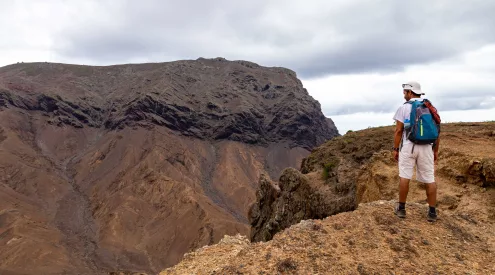Any road maintenance activity, including grass cutting, is hazardous and utmost care needs to be exercised, for the safety of both workers and motorists.
Roadway agencies are encouraged to develop roadside vegetation management programs to identify potential hazards and define the best maintenance practices for each location. An integrated roadside vegetation management program consists of eliminating or controlling vegetation through a variety of strategies including mowing, brush cutting (mechanical and hand), use of herbicides, grazing of livestock, cultivating desirable vegetation, and re-vegetation.
It is important to recognize that the law imposes on anyone carrying out an activity that may cause harm to others the duty to exercise ordinary care to avoid that harm. The law requires that we act reasonably under the circumstances. Failure to do so is negligence. In this section, we will focus on safety advice and protocols for those performing grass cutting and vegetation control.
The following are some of the most important reasons for effective vegetation control:
- Sight distance and keeping signs visible to drivers
- Improving visibility of livestock and wildlife near the road.
- Reducing fire risks with mowed shoulders creating a fire barrier.
- Inreased safety for roadside emergencies with more space for someone to safely pull off the road if required.
- Keeping road users (vehicles, bicycles and pedestrians) visible to drivers.
- Helping pedestrians and bicyclists see motor vehicles.
- Keeping sidewalks and pedestrian paths clear and free from overhanging vegetation.
- Removing trees close to the roadway which could result in a severe crash if hit.
- Improving winter road maintenance in snow and ice areas.
- Helping drainage systems function as designed.
- Preserving pavements through daylighting and root system control.
- Controlling noxious weeds in accordance with local environmental laws and ordinances.
The threats and risks presented to those cutting the crass
Each contractor does his own risk assessment, but these are some of the risks to the safety of workers doing vegetation control and cutting the grass:
- Grass cutting can involve the use of tractors and brush cutters, often in close proximity to the road.
- Becoming a road crash victim is a very real risk.
- Cuts, bruises and pinch-point injuries to the hands and feet.
- Damage to the eyes from flying chips or particles anytime you are using brush cutters, chain saws, brush chippers and string trimmers.
- Snake bites
- Health risks from prolonged exposure to the sun, i.e. skin cancer.
- Risks from severe weather such as lightning.
- Injuries to the head and limbs from falls and falling objects such as branches.
Measures to prevent injuries while performing grass cutting and vegetation control
- Wearing high visibility safety apparel to make you more visible to motorists.
- Leather gloves to protect your hands from cuts and nicks and lessen vibration when working with power tools.
- Safety glasses or goggles to protect your eyes from flying chips or particles anytime you are using brush cutters, chain saws, brush chippers and string trimmers.
- Hard hat to protect your head from a falling limb or flying debris during cutting and clearing.
- Proper footwear (usually a good sturdy boot with ankle support) is important to protect your feet. A hardened toe cap reduces the chances of crushed toes.
- Safety chaps if a chain saw will be used.
- Using the correct power tools for the specific task at hand.
- Effective training on using power tools and cutting equipment.
Mowing Safely
The Department of Transportation in the US has offered the following safety suggestions on moving safely:
Do Not:
- Mow too often. This wastes money, exposes mowing crews to traffic hazards more than needed, and can damage the vegetation.
- Mow at the wrong time. Good timing reduces the frequency of mowing required by cutting the vegetation in the right stage of growth.
- Mow too short. Leaving the proper height helps maintain the stand of vegetation and keeps small litter objects hidden.
- Mow steep slopes if you don’t need to. Steep slopes increase the risk of mower accidents.
- Mow when wet. This is hard on equipment.
- Operate equipment carelessly and scar trees and shrubs. Mowing is tedious but care must be taken to avoid accidents and preserve valuable plantings.
Do
- Read the operator’s manual thoroughly.
- Protect yourself from the sun. Use the canopy on the mower. Wear sunscreen and a hat and shirt.
- Strip grass from around the tree, in a circle, to help avoid mower wounds that can kill trees. The radius of the circle should be 1 to 3 feet depending on the size of the tree. Remove low tree branches that can click an eye or throw the operator off balance.
- Mow in the direction of oncoming traffic. This results in less impact if a missile is thrown out and also provides better visibility.
- Ballast or weight the tractor properly.
- Mow steeper slopes with a side-mounted mower on a boom if the tractor unit remains on flatter surfaces while mowing.
- Operate side-mounted or boom mower units on the uphill side of the tractor to limit the possibility of overturning the tractor.
- Be sure the mower has a rollover protection structure (ROPS). Use the seat belt at all times.
- Replace broken or lost chain guards to deflect debris immediately. Using flail type mowers reduces the amount of debris thrown.
- Cover all V-belts, drive chains and power takeoff shafts.
- Raise mowers when crossing driveways or roadways.
- Shut off power before checking any mower unit.
- Block a mower before changing, sharpening or replacing a blade. Any blade being reinstalled should be checked for cracks or damage that will lead to failure.
- Check for leaks before leaving the shop.
- Refuel away from waterways.
- Keep spill kits/materials on hand in case of oil or fuel leaks in the field.
- Use flashing lights and SlowMoving-Vehicle emblems and road signal to alert traffic.
- Use MOWING AHEAD or MOWING AREA signs or signs with similar legends to warn traffic.
- Signs should not be to more than one-two kilometres ahead of the mowing. As work progresses, move the signs so there are one to two miles between signs and the actual mowing work.
- Mount the signs on a breakaway portable support that will not be knocked over or blown down easily.
- Cover or remove the sign during lunch break or any other times when work is not in progress.
- Do not cover or remove the signs if you have stopped mowing to repair or adjust equipment because the warning to drivers is important to safety operations.
Safe Driving in Areas of Grass Cutting
- Slow down when approaching areas of grass cutting and vegetation control.
- Once you observe on which side of the road the activity is taking place, safely change lanes, if necessary, to be in the lane furthest from the activity.
- Apart from enhancing the workers’ safety, the change minimizes the risk of a stone being thrown up onto a vehicle.
High Visibility, Safety Signage and Safe Driving with Tractors
- Signage should always in place warning of grass cutting activities.
- Warning signs such as MOWING AHEAD, ROAD WORK AHEAD and similar signs may be placed along the road. The MOWING AHEAD sign is preferred.
- The sign is to be used in advance of mowing operations on the right-of-way. Place it on the shoulder so that approaching drivers can read the message easily
- Workers should be wearing reflective clothing to maximise visibility.
- Operate rotating yellow lights on mower tractors.
- Install SlowMoving-Vehicle emblems on all mower tractors.
- Always install yellow flasher lights on roll bars on the top of tractor cabs and operate these.
- Install an orange flag or pennant on a whip to show the location of the tractor in high grass or over the edge of slopes.
- Always operate the tractor with headlights on.
- Use a plate at the back of the mechanical mower to minimise stones flying towards the roadway.
Risk Assessment for Vegetation Control and Roadside Maintenance
| Activity Steps | Hazards & Risks | Preventative Measures | |
| 1 | Positioning of Flagmen | Flagmen not visible to oncoming traffic could cause fatality. | Flagmen to face oncoming traffic and be trained on the correct way of using the flag. Correct PPE to be warned at all times. |
| 2 | The positioning of Safety Signs | Workers not visible to the oncoming traffic could cause injury or fatality.
Signs not clearly visible to oncoming traffic. Injury and damage to property. |
Flagmen to pacify and warn oncoming traffic
Workers placing signage to face the traffic. Correct PPE to be worn at all times. Make sure signs are clean and in a good condition. Make sure the signs are stored in a good and correct way. |
| 3 | Work nearby and on public roads | Workers not visible to oncoming traffic can cause injuries and fatalities.
Construction vehicles not visible to oncoming traffic can cause serious injuries. Obstacles and hazards on the road can cause collisions with injury fatality and property damage. |
Flagmen not to leave position until given permission.Good voice communication to be maintained by the foreman and employees.
Vehicles to be fitted with rotating amber lights and signs warning the other vehicles and the public. Flagmen to pacify oncoming traffic and face oncoming traffic. Employees to be alert when collecting the hazards and be visible. Correct PPE. |
| 4 | Working in and around the site | Oncoming traffic not spotting construction workers.
Unsafe acts by employees can cause injuries or fatalities. |
Construction workers not permitted in the road without permission from the supervisor. Unless in a case of an emergency.
Employees to be informed of safety rules during induction. Supervisor to monitor and enforce them. |
| 5 | Working outdoors | Exposure to cold.
Inability to use the tools which can cause injuries. Exposure to the sun. Heat exhaustion. Exposure to rain can cause illness and time loss in the long run. Sun and wind exposure can cause dehydration. |
Correct PPE jackets and gloves.
Drinking water available Shaded rest areas. Rain suits to be issued. Supervisor to stop work in case of heavy rain. Drinking water available. |
| 6 | Use of Weed Eaters | Foreign objects in eyes, damage to eyes.
Slips and falls while using tools can cause injury or broken bones. Repetitive motion injuries from excessive hours use of tools Back injuries. Employees not trained to use the tool can cause injuries. Trimming area not cleared of debris. Injury caused by flying particles from the weed eaters or portable tools. Fuel spillage. Fire resulting in burns. Injury. Grass and debris pile on the weed eater. Fire resulting in injury. |
Correct PPE to be worn.
Correct PPE to be worn and check for hazards on the slope. 2-3 hours sessions with enough breaks. The supervisor should rotate workers daily/weekly. Use the manufactures manual to train the employees on the correct method. Supervisor to make sure the area is cleared: wire, stones, sticks, etc. Stop the weed-eating abruptly. Machine guarding. After use secure weed eaters to avoid spillage or damage when moving equipment. Use a fire-safe muffler in dry conditions. Make sure engine is cooled down when refuelling Debris pile on is a fire hazard. |











